William Thomas Easterbrook
Able Seaman, Service Number 206711, Royal Navy
22nd March 1883 – 22nd September 1914
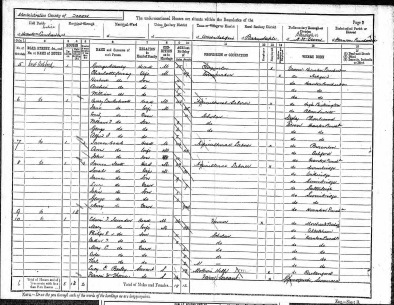
Born on Thursday the 22nd of March 1883 at Heanton Punchardon, William Thomas Easterbrook was the fourth child of Jane and Henry Easterbrook, who eventually had a total of ten children, ranging from William’s eldest sister Alice, who was born in 1875, to his youngest sister Ada, who was born in 1898.
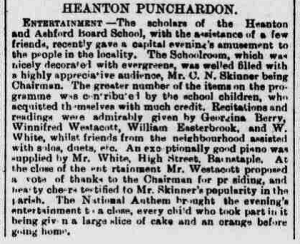 On Thursday the 25th of February 1892 the nine year old William made an appearance in the North Devon Journal in an article that read as follows: “The scholars of the Heanton and Ashford Board School, with the assistance of a few friends, recently gave a capital evening’s amusement to the people in the locality. The Schoolroom, which was nicely decorated with evergreens, was welled [sic] filled with a highly appreciative audience, Mr. O. N. Skinner being Chairman. The greater number of the items on the programme was contributed by the school children, who acquitted themselves with much credit. Recitations and readings were admirably given by Georgina Berry, Winnifred Westacott, William Easterbrook and W. White, whilst friends from the neighbourhood assisted with solos, duets, etc… The National Anthem brought the evening’s entertainment to a close, every child who took part in it being given a large slice of cake and an orange before going home.”
On Thursday the 25th of February 1892 the nine year old William made an appearance in the North Devon Journal in an article that read as follows: “The scholars of the Heanton and Ashford Board School, with the assistance of a few friends, recently gave a capital evening’s amusement to the people in the locality. The Schoolroom, which was nicely decorated with evergreens, was welled [sic] filled with a highly appreciative audience, Mr. O. N. Skinner being Chairman. The greater number of the items on the programme was contributed by the school children, who acquitted themselves with much credit. Recitations and readings were admirably given by Georgina Berry, Winnifred Westacott, William Easterbrook and W. White, whilst friends from the neighbourhood assisted with solos, duets, etc… The National Anthem brought the evening’s entertainment to a close, every child who took part in it being given a large slice of cake and an orange before going home.”
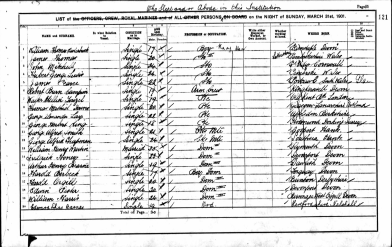
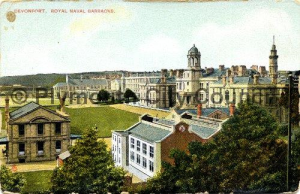 On the census of 1901, William is listed as being stationed at the Royal Naval Barracks at Stoke, Devonport, where he learnt the skills necessary to become a competent sailor on-board one of the boys training ships docked there.
On the census of 1901, William is listed as being stationed at the Royal Naval Barracks at Stoke, Devonport, where he learnt the skills necessary to become a competent sailor on-board one of the boys training ships docked there.
In December 1909, William married Hannah Margaret Edwards (known to her friends and family as Nancy), who was born in 1884 in Cardiff, Glamorgan, Wales, and who had moved to Barnstaple with her parents George and Elizabeth, along with her brother George and her sister Elizabeth, by the time of the 1901 census.
On the 25th of July 1910 Hannah and William’s first child, Hannah Margaret (Nancy), was born. She was followed on the 25th of April 1914 by her younger brother William Thomas (Tom), who was almost five months old when his father was killed in action.
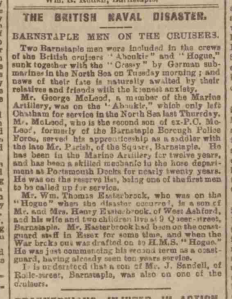 At the outbreak of World War I William had, according to a War Item contained in the North Devon Journal of Thursday the 24th of September 1914, “been on the coast guard staff in Essex for some time,” and was “just commencing his second term as a coast guard, having already seen ten years’ service.” According to William’s descendants those ten years of service were in fact with the Royal Navy “and [he] had recently left the service to become a Coastguard at Canvey Island.” The fact that he spent most of his time out at sea explains why he was not at home in Barnstaple with his wife and child when the census of 1911 was taken.
At the outbreak of World War I William had, according to a War Item contained in the North Devon Journal of Thursday the 24th of September 1914, “been on the coast guard staff in Essex for some time,” and was “just commencing his second term as a coast guard, having already seen ten years’ service.” According to William’s descendants those ten years of service were in fact with the Royal Navy “and [he] had recently left the service to become a Coastguard at Canvey Island.” The fact that he spent most of his time out at sea explains why he was not at home in Barnstaple with his wife and child when the census of 1911 was taken.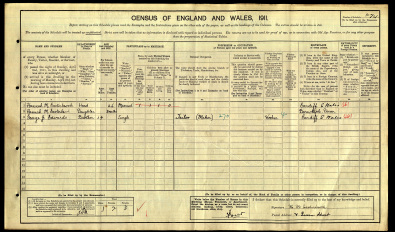
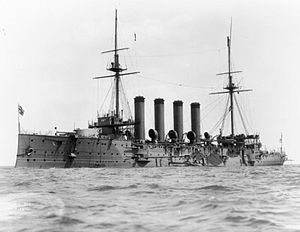
When war with Germany broke out, William was drafted back into the Royal Navy as a reservist and stationed aboard the HMS Hogue, a Bacchante-class armoured cruiser launched on the 13th of August 1900 and that was, by the year 1914, technically obsolete. At this time, Hogue was a part of 7th Cruiser Squadron, alongside five other cruisers of the same outdated type – within the Royal Navy it was considered extremely dangerous to be posted to this squadron, leading to it being unofficially christened “the Live Bait Squadron.” First Lord of the Admiralty Winston Churchill was one of a number of officials who had recommended that the Bacchante-class ships be withdrawn from service; however this suggestion was overruled on the grounds that there were no modern ships to replace them. It was eventually agreed, in the third week of September, that they would remain active until the arrival of the new Arethusa-class cruisers then being built.
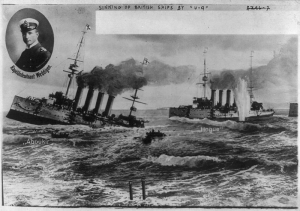 On Tuesday the 22nd of September 1914, the cruisers Aboukir, Cressy and Hogue were on patrol in an area of the North Sea off the Netherlands known as the “Broad Fourteens” when they were attacked by the German submarine U-9. Aboukir was the first of the ships to be torpedoed – Hogue and Cressy were both struck whilst attempting to rescue the survivors. Approximately an hour and a half after the first torpedo hit, all three vessels were fully submerged. Dutch sailing trawlers in the vicinity succeeded in rescuing 837 men, however, by the time they arrived 1,459 of the combined crew of 7th Cruiser Squadron had already lost their lives, amongst them Able Seaman William Thomas Easterbrook, 206711, RN, aged 31 years.
On Tuesday the 22nd of September 1914, the cruisers Aboukir, Cressy and Hogue were on patrol in an area of the North Sea off the Netherlands known as the “Broad Fourteens” when they were attacked by the German submarine U-9. Aboukir was the first of the ships to be torpedoed – Hogue and Cressy were both struck whilst attempting to rescue the survivors. Approximately an hour and a half after the first torpedo hit, all three vessels were fully submerged. Dutch sailing trawlers in the vicinity succeeded in rescuing 837 men, however, by the time they arrived 1,459 of the combined crew of 7th Cruiser Squadron had already lost their lives, amongst them Able Seaman William Thomas Easterbrook, 206711, RN, aged 31 years.
The incident caused a public outcry within Britain and severely damaged the reputation of the Royal Navy worldwide, and the remaining Bacchante cruisers were withdrawn from active duty. Furthermore, from that time onwards the threat from submarines was taken far more seriously. As Commander, later First Sea Lord, Dudley Pound noted in his diary two days after the attack, “Much as one regrets the loss of life one cannot help thinking that it is a useful warning to us – we had almost begun to consider the German submarines as no good and our awakening which had to come sooner or later might have been accompanied by the loss of some of our Battle Fleet.”
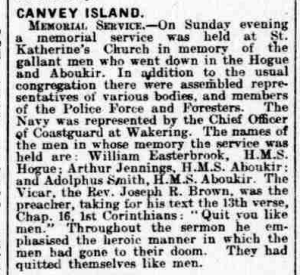 The Royal Navy were unable to retrieve William’s body for burial. In the words of his Granddaughter, “On the day my Grandmother received the telegram that her husband was missing she was due to move to start a new life in Canvey Island. The furniture had already gone and the breakfast dishes were still on the table.
The Royal Navy were unable to retrieve William’s body for burial. In the words of his Granddaughter, “On the day my Grandmother received the telegram that her husband was missing she was due to move to start a new life in Canvey Island. The furniture had already gone and the breakfast dishes were still on the table.
This must have been a very difficult time for my Gran. Her sister, who lived at Ashford, helped with the children, but she also had a young family and I think her husband had also gone to serve in the war.
Meanwhile my Gran went to work in the Munitions Factory; this must have been a very difficult time for her, suffering the bereavement of her husband and separation from her two children.
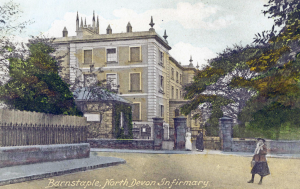 Eventually she developed white lead poisoning and was very ill for a long time (my Mother said a year). At one stage her death seemed imminent and my Mother could remember being taken with her brother Tom to see her in the North Devon Infirmary and she didn’t recognise her.
Eventually she developed white lead poisoning and was very ill for a long time (my Mother said a year). At one stage her death seemed imminent and my Mother could remember being taken with her brother Tom to see her in the North Devon Infirmary and she didn’t recognise her.
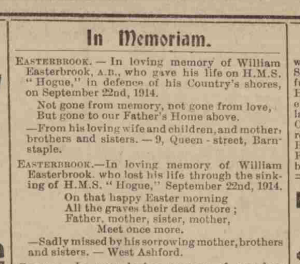
I have many lovely memories of my Gran, but I never liked Remembrance Sunday as she was always very sad and tearful.”
On Thursday the 23rd of September 1915 the North Devon Journal contained the following memorial: “In loving memory of William Easterbrook, A.B., who gave his life on H.M.S. “Hogue,” in defence of his Country’s shores, on September 22nd, 1914.
Not gone from memory,
Not gone from love,
But gone to our Father’s home above.
From his loving wife and children, and mother, brothers and sisters.”
RL
Hi there. I am on Canvey Island and have a little research in to the WW1 heroes of Canvey. Wm. Easterbook is on Canvey’s WW1 Plaque. I would love to contact the relatives of Wm. Easterbrook.
Contact MartinLepley@gmail.com
LikeLike
Thank you Martin for this and your e-mails to our main mailbox. We hope that Wm Easterbrook’s relatives will be in touch with you soon.
LikeLike